|
|
Despite being one of the last habitable land masses on earth to be settled by man, Madagascar has lost more of its forests than most countries; less than 10% of its original forest cover now remains, and much of that is degraded. Political turmoil that erupted earlier this year continues to rumble on and the ensuing lawlessness has created the opportunity for illegal logging syndicates to plunder national parks, most notably Marojejy and Masoala, for valuable hardwoods and wildlife.
This bleak scenario is a far cry from the rule of ousted President Marc Ravalomanana (July 2002 to March 2009) during which protected areas were tripled to cover 10% of the country’s surface. Madagascar has become exemplary in its approaches to conservation of natural assets, this tripling of protected areas being a mainstay of President Ravalomanana’s ambitious five-year Madagascar Action Plan. However since former mayor of Antananarivo Andry Rajoelina took power of the country in what has been widely viewed as a coup d’état, confusion, chaos and lawlessness have reigned and the conservation initiatives previously in place now appear to be in jeopardy.
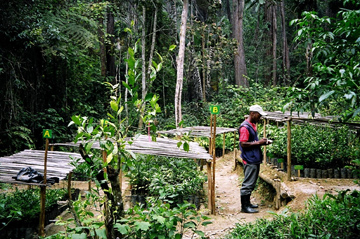 Association Mitsinjo’s nursery at Station Forestier d’Analamazaotra, opposite ‘Perinet’ – photo: Derek Schuurman |
While rampant deforestation continues in some parts of the island, elsewhere inspiring reforestation initiatives are being carried out, which tourists can visit and get involved with. What better way could there be of – quite literally – putting something back into a country than planting an endemic tree in its natural range? Such gratifying experiences, which allow tourists to make meaningful connections with the environment rather than simply being an observer, are offered by forest recovery projects that are being developed in various habitat types throughout Madagascar.
Endemic tree species are being propagated in a growing number of nurseries, funded and managed by NGOs such as Association Mitsinjo and Man And The Environment; far-sighted hotels such as Anjajavy and Le Domaine de Fontenay; organizations which arrange conservation-oriented tours for volunteer workers such as ReefDoctor; and some foreign tour operators specializing in Madagascar, such as Rainbow Tours. The aim of such projects is usually to grow saplings in nurseries and then use them to restore degraded habitats to a more healthy state.
In this article we will review some of the most accessible forest recovery programs in the very different forest types of Madagascar.
ASSOCIATION MITSINJO: MID-ALTITUDE MONTANE RAINFOREST
Association Mitsinjo, which administers the 700 ha Analamazaotra Forest Station in eastern Madagascar, is setting a high standard of ecotourism involving local communities. We spoke with Dr Rainer Dolch, Technical Director of the project: ‘Mitsinjo evolved out of a community project and does a lot for the community,’ Dr Dolch explains. ‘We are currently employing around a hundred people, providing agricultural training and environmental education in schools and elsewhere.’
Founded in 1999 by a dozen young men and women in Andasibe, Mitsinjo began as a guiding association but rapidly evolved into an NGO that now aims to alleviate rural poverty and protect the environment of the Andasibe region. Tourist-generated revenue is used to finance its multifarious conservation and development activities.
Mitsinjo has since become a key example of forest restoration and carbon sequestration. The association’s own nursery in the Analamazaotra Forest Station has many thousands of saplings of around 100 endemic tree species. ‘If visitors wish to plant an endemic tree as part of their visit to Andasibe, we are happy to help,’ says Dr Dolch. The Analamazaotra Forest Station offers plenty of space for restoration and, after exploring the rainforest, people are welcome to be accompanied by one of our guides who will advise them where and how to plant a tree. Saplings would of course be taken from the Mitsinjo nursery.’
‘I would really appreciate if a typical visit to Andasibe included a visit to Analamazaotra Forest Station, together with tree planting and a night-time hike to discover the rainforest’s nocturnal denizens,’ Dr Dolch adds. ‘We could make the planting an integral part of the circuit. Or if visitors preferred to just do the tree planting, then we would just ask for a small fee or donation.’
Today, some members of the association are highly skilled guides. Madagascar National Parks implemented a rule in 2008 prohibiting night walks in all the protected areas it administers, but people who come to Andasibe-Mantadia/Périnet (Madagascar’s most-visited national park) can still see the area’s nocturnal wildlife with the guides of Association Mitsinjo. Such walks can be done in the Analamazaotra Forest Station just opposite the Andasibe entrance. Tourists are also able to explore the forest canopy at the station, and entry fees are much lower than at national parks.
MAN AND THE ENVIRONMENT – PROJECT VOHIBOLA: LOWLAND RAINFOREST
Situated on the Pangalanes Canal to the south of Tamatave, Vohibola is one of the last two remaining examples of east coast littoral forest. When the Missouri Botanical Garden inventoried the forests here, they discovered three of the world’s most endangered tree species, including Humbertiodendron saboureaui; a species unseen for 50 years and presumed extinct.
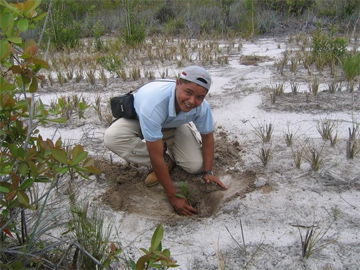 Professional wildlife guide Toky Andrianamoro planting an endemic tree at Vohibola – photo: Derek Schuurman |
In 2001, Man And The Environment (MATE) assumed management of Vohibola. This Malagasy NGO, founded in 1993, works to create harmony between habitat preservation and the needs of local communities. MATE’s work involves management of the Vohimana rainforest and tree nurseries, and development projects with local villages, according to Olivier Behra, who heads the project. Two local villages have benefited from the development of fisheries, cultivation of plant crops for essential oils, and healthcare.
Vohimana, along with the Analamazaotra and Mantadia forests, forms part of the enormous – but fragmented – rainforest area of Mantadia-Vohidrazana. Since MATE has been active in the area, agreements have been reached with local and regional communities and national authorities to establish a 150 ha forest corridor from Vohimana to Mantadia.
The tree nurseries at Vohimana are geared towards cultivation of critically endangered endemics, fast-growing trees to restore forest cover, and useful species such as Calophyllum which is known for its medicinal properties. The nursery now contains over 80,000 seedlings of more than 100 species.
Visitors who wish to see Vohibola can do so by staying at hotels on the Pangalanes Canal such as the Palmarium and Bush House, from where boat trips can be arranged. Here you can be a part of the reforestation project by planting an endangered, endemic tree.
THE BUTTERFLY BREEDING AND REFORESTATION PROJECT AT MAKIRA: LOWLAND RAINFOREST
Former Peace Corps volunteer, Madagascar enthusiast and lepidopterist Maya Moore has helped to develop an inspired project which combines forest recovery with butterfly farming, thereby alleviating poverty through conservation. The nursery of butterfly host plants and other rainforest trees has been established in a degraded area south of Maroantsetra in northeastern Madagascar. The project staff are particularly interested in cultivating species with dual purposes such as cloves and moringas which can be both eaten and used for reforestation.
‘The pilot farm was established in 2006 by members of the local farmers’ association (FT/MTM) on the borders of the Makira Forest. The aim is to provide families with an alternative means of income,’ explains Ms Moore. Selected species of butterfly and moth, such as the sunset and comet moths, are bred in enclosures and then sold as framed souvenirs. ‘The project is based on successful models such as Kepipeo in Kenya and the Amani Farms of Tanzania,’ Ms Moore adds. ‘It creates economic incentives for the farmers to conserve their natural resources. It therefore reduces human pressure on the rainforest by establishing and demonstrating a clear link between preservation of intact rainforest and people’s livelihoods. Most importantly, it motivates local people to participate in reforestation of degraded countryside.’
MISSOURI BOTANICAL GARDEN: LOWLAND RAINFOREST AND EVERGREEN CENTRAL HIGH PLATEAU FOREST
Missouri Botanical Garden (MBG) has long been active in Madagascar, running several long-term projects, such as the extensive and ongoing cataloguing of plant species and training Malagasy natives with useful skills such as plant collection and identification. The garden now employs around 60 permanent staff in Madagascar, almost all of them Malagasy.
MBG has identified eleven priority sites for plant conservation in Madagascar where they are now carrying out community-based conservation to ‘integrate a highly motivated and well-educated conservation facilitator into the communities adjacent to the sites.’ As with similar projects being carried out elsewhere, the focus remains on supporting and empowering local communities to manage their natural resources in a sustainable way.
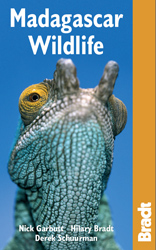 | Beautifully illustrated with full color photographs throughout, Madagascar Wildlife is a celebration of the unique fauna of a remarkable island and the perfect accompaniment to Bradt’s popular general travel guide, Madagascar. |
In a recent report from the restoration team involved in two pilot projects at Ankafobe and Analalava, MBG proposes that ‘it now seems essential to widen the focus and consider conservation sites as they really are, part of a broader landscape that must be managed as a whole.’ MBG are working to restore the natural capital of these regions to secure the biodiversity and people from threats such as climate change and overexploitation.
Despite being highly degraded, the 200ha fragment of low-elevation humid forest at Analalava, a few kilometres south of Foulpointe in eastern Madagascar, is of high conservation value. It is the only remaining tract of forest in the area and supports a wealth of biodiversity including 26 species of palm and five other plants now found nowhere else, five lemur species, and a multitude of undescribed reptile and amphibian species. The MBG restoration team at Analalava have been experimenting with various techniques and comparing them with traditional methods to determine the most effective means of restoring natural capital in the area. From these trials, the team has established the best time of year to plant trees (December, just prior to the wet season) and developed successful techniques for the planting and propagation of seedlings and saplings in nurseries and degraded ground.
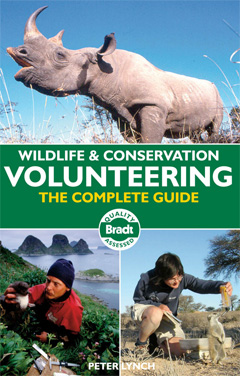 Volunteering guide. Exclusive discount code for Mongabay readers to give them 30% discount off this title when they order through the Bradt website and quote coupon code MONGABAY30 at checkout. |
As part of the same project, MBG are running similar activities at Ankafobe, a complex of small, degraded forest fragments in the central high plateau of Madagascar. Much of the remaining population of Schizolaena tampoketsana – one of Madagascar’s most threatened trees – is found in this region which is a rare example of the forest type thought to have covered much of the high plateau before man arrived on the island.
Activities at Ankafobe have involved both ‘active’ and ‘passive’ restoration: the former consisting of planting nursery-raised seedlings in a degraded area of the forest, and the latter being prevention of further fire damage with the creation of over 5 km of firebreaks. In January alone 3,750 seedlings of 19 tree species were planted. Fire prevention methods proved to be extremely effective; none of the frequent fires that occurred in the surrounding grassland spread to the forest.
Road-weary tourists may visit one of the Ankafobe forest fragments, conveniently situated adjacent to the road linking Antananarivo with Majunga (RN4), a route often frequented by tourists. The site provides a pleasant break in a long journey for travelers, and includes a 1 km trail that passes through savanna, valley-bottom marsh and forest, with educational signs and labelled trees. There is no charge to visit the grounds; tourists are instead asked to buy a project t-shirt, proceeds from which are used to conserve the site.
ANJAJAVY L’HOTEL AND RAINBOW TOURS: WESTERN SEASONALLY DRY FORESTS
Situated on a remote peninsula on the northwest coast of Madagascar, the grounds of Anjajavy l’Hotel encompass a diversity of habitats, from seasonally dry forest (home to three species of baobab tree) and exceptionally healthy mangroves to beaches, offshore islets and caves. The 670 ha Anjajavy Reserve was established relatively recently and not a moment too soon; seasonally dry deciduous forests are the island’s most threatened, fragile and fragmented forest type.
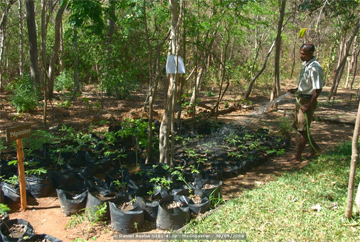 Anjajavy Nursery. Photo by Daniel Austin |
For the past four years the UK’s leading Madagascar specialist tour operator, Rainbow Tours, has been funding a tree nursery at the reserve. Cultivated species include the precious hardwood Palisander and endemic baobabs such as Adansonia madagascariensis. There is also a second, larger, tree nursery at Anjajavy, established by Olivier Behra of MATE. Again, the objective of the nurseries is the recovery of forest in degraded areas, a particularly challenging task in western Madagascar where endemic trees are mostly slow-growing. Visitors can help the project by planting a tree at the reserve or making a donation.
REEFDOCTOR: SPINY BUSH
Of all the forest types in Madagascar, the spiny bush is the most distinctive, aptly described by travel writer Dervla Murphy as ‘nature’s botanical lunatic asylum’. Bloated baobabs, prickly pachypodiums, ‘drumstick’ moringas and other endemic trees are interspersed with euphorbias and the tall, spiny trees of the Didiereaceae family. Nowhere does this habitat type look as impressive as it does to the north of Tulear (southwest Madagascar), but nowhere is it more threatened. The Veso and Antandroy people living here are among the island’s poorest, eking out an existence in a harsh environment that some years receives no rain at all. Every year the spiny bush shrinks, as large areas of trees are felled by charcoal sellers. Where meagre crops of maize are grown, much of the harvest is sent to Mauritius as livestock fodder.
William Mitchell of ReefDoctor, an organization actively working in the area to preserve the marine and terrestrial environment in tandem with alleviating rural poverty, tells us that Project Ho Avy is still in its primary stages of development but is making steady progress.
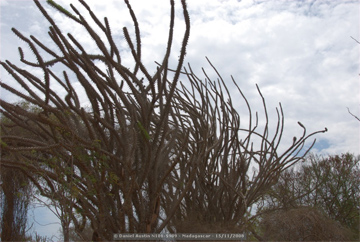 Spiny bush. Photo by Daniel Austin |
The project is overseen by a past ReefDoctor staff member Martina Petru. Since the beginning of 2008 Ho Avy have established collaborative relationships with the village of Ranobe, facilitated the setting up of the Ranobe village association FIMPAHARA and created the New Latitude pilot nursery, where more than 800 native tree species are being cultivated for reforestation. The nursery includes vegetables and fruit trees to boost local food production, and medicinal plants. Local biodiversity is maintained by planting heavily exploited endemic trees, simultaneously creating new jobs for local people as gardeners and merchants at local markets where surplus vegetables are sold to support the local economy.
Through ReefDoctor, you can take a day trip to the mangrove conservation project Honco, to participate in research and management activities under way to restore the mangrove ecosystems in the Tulear region. Tourists can also see the how the work of Ho Avy is helping farmers living in the spiny bush with more sustainable crop-growing techniques, water usage and re-growth of indigenous medicinal plants and trees.
We would like to thank Maya Moore, Lucienne Wilme, Christian Camara, Daniel Austin, Rainer Dolch and Olivier Behra for their assistance with this article.
Kara Moses is a freelance writer, editor and primatologist. She has contributed to a number of books including Ian Redmond’s Primates Of The World and Borneo: The Bradt Guide and writes articles about primates and environmental issues for publications such as BBC Wildlife magazine and websites such as Mongabay.com.
Derek Schuurman is co-author of ‘Madagascar Wildlife: a Visitors Guide‘ and ‘Globetrotter Madagascar Guide‘, contributor to the Conservation International Field Guide on the Lemurs of Madagascar (2nd ed) and Madagascar: The Bradt Guide, and has written numerous articles since first visiting the island in 1992.